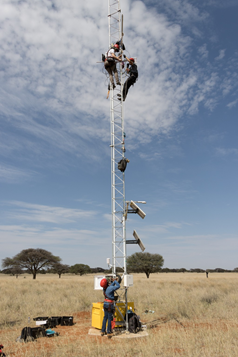SEACRIFOG Project – Designing long-term GHG observation in Africa
More than half of Africa’s greenhouse gas (GHG) emissions are estimated to appear from Agriculture and the LULUCF sector. This rather high share and the total emissions rate of Africa is quite uncertain, since there is a lack of basic, qualitative and open accessible measurements and inventories in large parts of the continent and its biomes. The H2020 funded SEACRIFOG Project has started in early 2017 to develop a roadmap on how to overcome these gaps and build a comprehensive GHG observation system in Africa. The interdisciplinary African-European working team comprises experts in atmospheric, terrestrial (agricultural) and ocean observation.

As a first step stakeholders were searched, contacted and visited during three different scientific events in West, East and Southern Africa. During the consultation workshops, the needs and gaps for GHG monitoring were discussed. The low accessibility of needed data and the need for more well educated staff, able to measure, model and interpret GHG data were mentioned. As a second step within the project it was assessed, which variables need to be measured or collected for efficient GHG monitoring. Afterwards, it was collected which measurements, data products and corresponding networks already exist or are being created in the Africa context. The database is publicly available and can be up-dated if new information arises. Scientists and policy makers can easily see which data are available in a specific country and how to access them.
Besides the assessment of existing structures, an analysis of how a basic data infrastructure for the observation data could be established and a comprehensive calculation of, where new tall tower infrastructure would need to be established to reduce a maximum of uncertainty of atmospheric measurements were carried out (corresponding paper will be published soon). Finally, a cost calculation for the proposed observation and data infrastructure shows an estimated amount of 500 M€ investment over 30 years. A significant half of the budget is planned to support human and institutional capacity building to assure local personnel for the infrastructure for local ownership.
The first meeting of the SEACRIFOG Dialogue Platform (SDP) was held on 6 July 2020. The SDP is an advisory body providing strategic and policy-related guidance inclusively. The SDP will accompany the implementation of the SEACRIFOG project into an infrastructure for GHG observations on the African continent. Future objectives and roadmaps will be set, and long-term funding strategies sought and discussed. Due to the Covid 19 crisis, the meeting was held virtual to inform the SDP members about the project’s results. 25 participants of regional or global multilateral organizations (UNFCCC, FAO, GEO, WMO), development banks, the RECs, national meteorological services, scientific societies and academies, national ministries (Europe and Africa) and the private sector joined. At the end of the meeting a lively discussion evolved. It was pointed out that there are manifold opportunities for Africa to create a science sector to observe and lower GHG emissions. Moreover, the need for national, regional and international cooperation of institutions and governments to overcome observation gaps in Africa was pointed out. The roadmap developed by SEACRIFOG itself is not enough to support ambitious NDCs, but it paves the way for a future implementation of the comprehensive African GHG observation system, which will help African policy makers to develop realistic and traceable mitigation goals.
